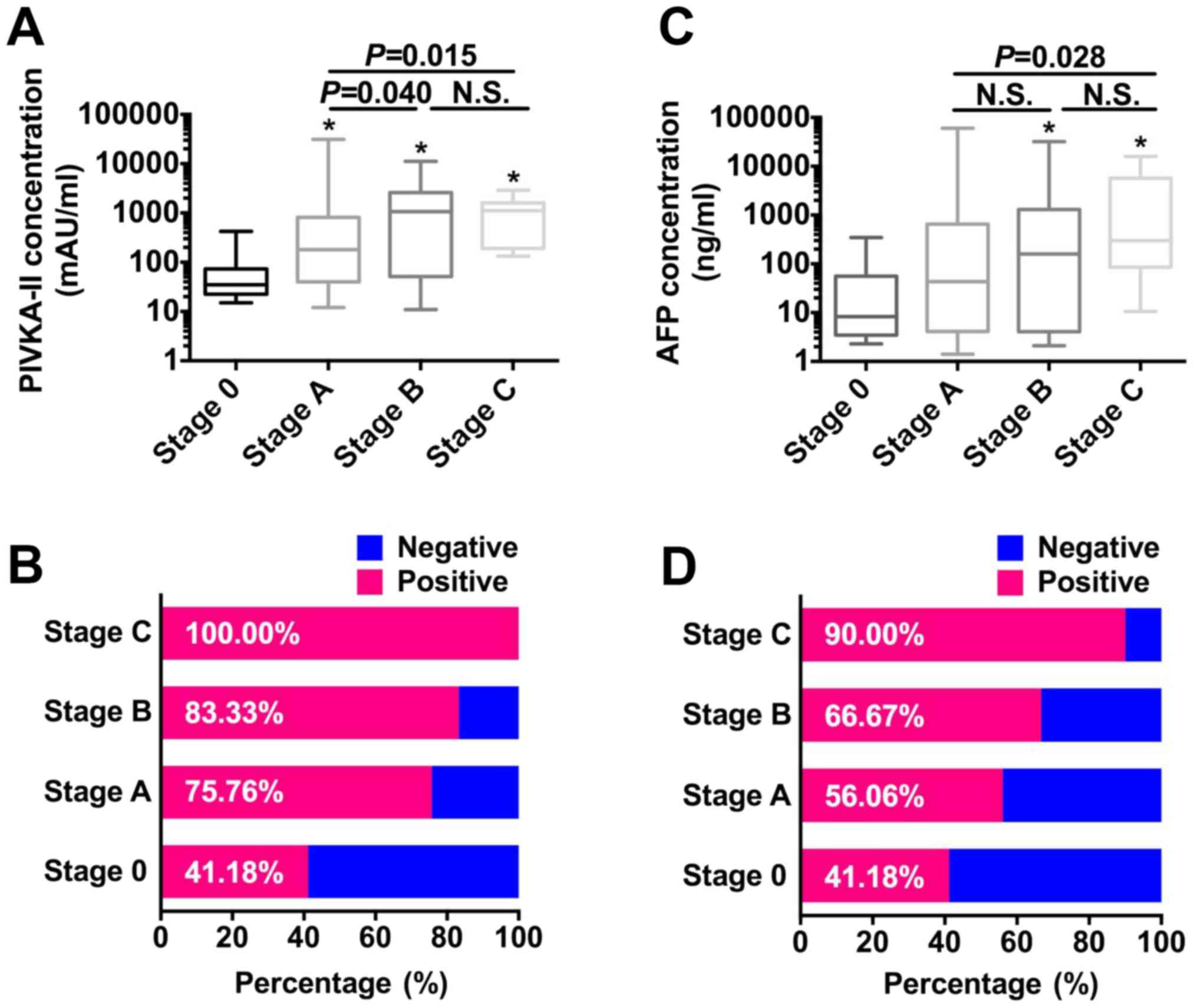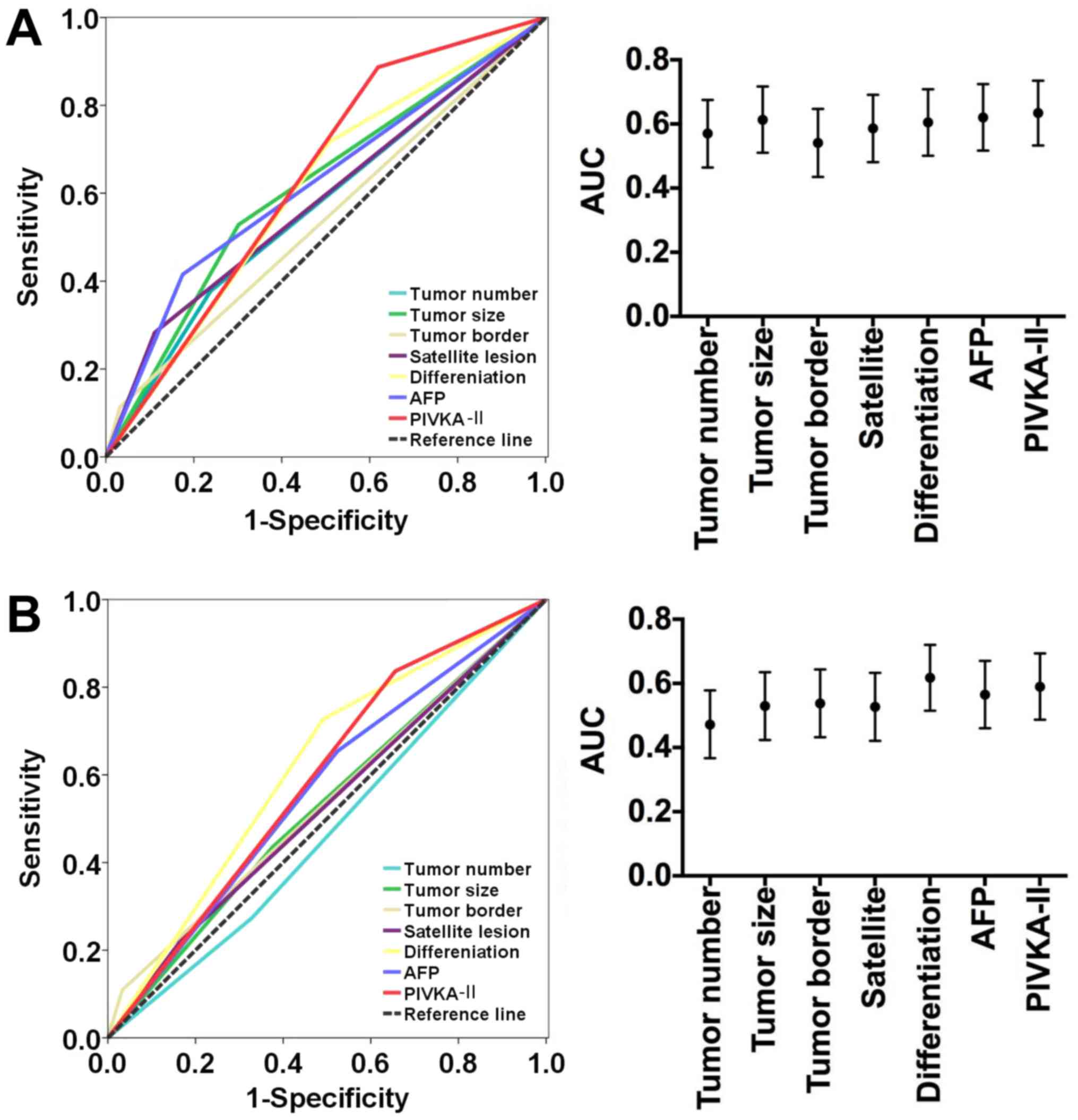|
1
|
Siegel RL, Miller KD and Jemal A: Cancer
statistics, 2016. CA Cancer J Clin. 66:7–30. 2016. View Article : Google Scholar : PubMed/NCBI
|
|
2
|
Levrero M and Zucman-Rossi J: Mechanisms
of HBV-induced hepatocellular carcinoma. J Hepatol. 64 Suppl
1:S84–S101. 2016. View Article : Google Scholar : PubMed/NCBI
|
|
3
|
Chen W, Zheng R, Baade PD, Zhang S, Zeng
H, Bray F, Jemal A, Yu XQ and He J: Cancer statistics in China,
2015. CA Cancer J Clin. 66:115–132. 2016. View Article : Google Scholar : PubMed/NCBI
|
|
4
|
Bruix J and Sherman M: American
Association for the Study of Liver Diseases: Management of
hepatocellular carcinoma: An update. Hepatology. 53:1020–1022.
2011. View Article : Google Scholar : PubMed/NCBI
|
|
5
|
Bruix J, Reig M and Sherman M:
Evidence-based diagnosis, staging and treatment of patients with
hepatocellular carcinoma. Gastroenterology. 150:835–853. 2016.
View Article : Google Scholar : PubMed/NCBI
|
|
6
|
Dhanasekaran R, Venkatesh SK, Torbenson MS
and Roberts LR: Clinical implications of basic research in
hepatocellular carcinoma. J Hepatol. 64:736–745. 2016. View Article : Google Scholar : PubMed/NCBI
|
|
7
|
Prieto J, Melero I and Sangro B:
Immunological landscape and immunotherapy of hepatocellular
carcinoma. Nat Rev Gastroenterol Hepatol. 12:681–700. 2015.
View Article : Google Scholar : PubMed/NCBI
|
|
8
|
Zhu GQ, Shi KQ, Yu HJ, He SY, Braddock M,
Zhou MT, Chen YP and Zheng MH: Optimal adjuvant therapy for
resected hepatocellular carcinoma: A systematic review with network
meta-analysis. Oncotarget. 6:18151–18161. 2015. View Article : Google Scholar : PubMed/NCBI
|
|
9
|
Guo W, Yang XR, Sun YF, Shen MN, Ma XL, Wu
J, Zhang CY, Zhou Y, Xu Y, Hu B, et al: Clinical significance of
EpCAM mRNA-positive circulating tumor cells in hepatocellular
carcinoma by an optimized negative enrichment and qRT-PCR-based
platform. Clin Cancer Res. 20:4794–4805. 2014. View Article : Google Scholar : PubMed/NCBI
|
|
10
|
Yang XR, Xu Y, Shi GM, Fan J, Zhou J, Ji
Y, Sun HC, Qiu SJ, Yu B, Gao Q, et al: Cytokeratin 10 and
cytokeratin 19: Predictive markers for poor prognosis in
hepatocellular carcinoma patients after curative resection. Clin
Cancer Res. 14:3850–3859. 2008. View Article : Google Scholar : PubMed/NCBI
|
|
11
|
Shen Q, Fan J, Yang XR, Tan Y, Zhao W, Xu
Y, Wang N, Niu Y, Wu Z, Zhou J, et al: Serum DKK1 as a protein
biomarker for the diagnosis of hepatocellular carcinoma: A
large-scale, multicentre study. Lancet Oncol. 13:817–826. 2012.
View Article : Google Scholar : PubMed/NCBI
|
|
12
|
Li C, Zhang Z, Zhang P and Liu J:
Diagnostic accuracy of des-gamma-carboxy prothrombin versus
α-fetoprotein for hepatocellular carcinoma: A systematic review.
Hepatol Res. 44:E11–E25. 2014. View Article : Google Scholar : PubMed/NCBI
|
|
13
|
Singal A, Volk ML, Waljee A, Salgia R,
Higgins P, Rogers MA and Marrero JA: Meta-analysis: Surveillance
with ultrasound for early-stage hepatocellular carcinoma in
patients with cirrhosis. Aliment Pharmacol Ther. 30:37–47. 2009.
View Article : Google Scholar : PubMed/NCBI
|
|
14
|
Meguro M, Mizuguchi T, Nishidate T, Okita
K, Ishii M, Ota S, Ueki T, Akizuki E and Hirata K: Prognostic roles
of preoperative α-fetoprotein and des-γ-carboxy prothrombin in
hepatocellular carcinoma patients. World J Gastroenterol.
21:4933–4945. 2015. View Article : Google Scholar : PubMed/NCBI
|
|
15
|
Kim JM, Hyuck C, Kwon D, Joh JW, Lee JH,
Paik SW and Park CK: Protein induced by vitamin K antagonist-II
(PIVKA-II) is a reliable prognostic factor in small hepatocellular
carcinoma. World J Surg. 37:1371–1378. 2013. View Article : Google Scholar : PubMed/NCBI
|
|
16
|
Ji J, Wang H, Li Y, Zheng L, Yin Y, Zou Z,
Zhou F, Zhou W, Shen F and Gao C: Diagnostic evaluation of
des-gamma-carboxy prothrombin versus α-fetoprotein for hepatitis B
virus-related hepatocellular carcinoma in China: A Large-Scale,
Multicentre study. PLoS One. 11:e01532272016. View Article : Google Scholar : PubMed/NCBI
|
|
17
|
Weitz IC and Liebman HA: Des-gamma-carboxy
(abnormal) prothrombin and hepatocellular carcinoma: A critical
review. Hepatology. 18:990–997. 1993. View Article : Google Scholar : PubMed/NCBI
|
|
18
|
Lok AS, Sterling RK, Everhart JE, Wright
EC, Hoefs JC, Di Biscegile AM, Morgan TR, Kim HY, Lee WM, Bonkovsky
HL, et al: Des-gamma-carboxy prothrombin and alpha-fetoprotein as
biomarkers for the early detection of hepatocellular carcinoma.
Gastroenterology. 138:493–502. 2010. View Article : Google Scholar : PubMed/NCBI
|
|
19
|
Poté N, Cauchy F, Albuquerque M, Voitot H,
Belghiti J, Castera L, Puy H, Bedossa P and Paradis V: Performance
of PIVKA-II for early hepatocellular carcinoma diagnosis and
prediction of microvascular invasion. J Hepatol. 62:848–854. 2015.
View Article : Google Scholar : PubMed/NCBI
|
|
20
|
Kamiyama T, Yokoo H, Kakisaka T, Orimo T,
Wakayama K, Kamachi H, Tsuruga Y, Yanmashita K, Shimamura T, Todo S
and Taketomi A: Multiplication of alpha-fetoprotein and protein
induced by vitamin K absence-II is a powerful predictor of
prognosis and recurrence in hepatocellular carcinoma patients after
a hepatectomy. Hepatol Res. 45:E21–E31. 2015. View Article : Google Scholar : PubMed/NCBI
|
|
21
|
Masuda T, Beppu T, Okabe H, Nitta H, Imai
K, Hayashi H, Chikamoto A, Yamamoto K, Ikeshima S, Kuramoto M, et
al: Predictive factors of pathological vascular invasion in
hepatocellular carcinoma within 3 cm and three nodules without
radiological vascular invasion. Hepatol Res. 46:985–991. 2016.
View Article : Google Scholar : PubMed/NCBI
|
|
22
|
Kondo Y, Kimura O and Shimosegawa T:
Significant biomarkers for the management of hepatocellular
carcinoma. Clin J Gastroenterol. 8:109–115. 2015. View Article : Google Scholar : PubMed/NCBI
|
|
23
|
Hu B, Yang XR, Xu Y, Sun YF, Sun C, Guo W,
Zhang X, Wang WM, Qiu SJ, Zhou J and Fan J: Systemic
immune-inflammation index predicts prognosis of patients after
curative resection for hepatocellular carcinoma. Clin Cancer Res.
20:6212–6222. 2014. View Article : Google Scholar : PubMed/NCBI
|
|
24
|
Cucchetti A, Piscaglia F, Grigioni AD,
Ravaioli M, Cescon M, Zanello M, Grazi GL, Golfieri R, Grigioni WF
and Pinna AD: Preoperative prediction of hepatocellular carcinoma
tumour grade and micro-vascular invasion by means of artificial
neural network: A pilot study. J Hepatol. 52:880–888. 2010.
View Article : Google Scholar : PubMed/NCBI
|
|
25
|
Rodriguez-Perálvarez M, Luong TV, Andreana
L, Meyer T, Dhillon AP and Burroughs AK: A systematic review of
microvascular invasion in hepatocellular carcinoma: Diagnostic and
prognostic variability. Ann Surg Oncol. 20:325–339. 2013.
View Article : Google Scholar : PubMed/NCBI
|
|
26
|
Zhang HM, Li SP, Yu Y, Wang Z, He JD, Xu
YJ, Zhang RX, Zhang JJ, Zhu ZJ and Shen ZY: Bi-directional roles of
IRF-1 on autophagy diminish its prognostic value as compared with
Ki67 in liver transplantation for hepatocellular carcinoma.
Oncotarget. 7:37979–37992. 2016.PubMed/NCBI
|
|
27
|
Altekruse SF, McGlynn KA, Dickie LA and
Kleiner DE: Hepatocellular carcinoma confirmation, treatment, and
survival in surveillance, epidemiology, and end results registries,
1992–2008. Hepatology. 55:476–482. 2012. View Article : Google Scholar : PubMed/NCBI
|
|
28
|
Yamashita Y, Tsuijita E, Takeishi K,
Fujiwara M, Kira S, Mori M, Aishima S, Taketomi A, Shirabe K,
Ishida T and Maehara Y: Predictors for microinvasion of small
hepatocellular carcinoma ≤2 cm. Ann Surg Oncol. 19:2027–2034. 2012.
View Article : Google Scholar : PubMed/NCBI
|
|
29
|
Schmilovitz-Weiss H, Tobar A, Halpern M,
Levy I, Shabtai E and Ben-Ari Z: Tissue expression of squamous
cellular carcinoma antigen and Ki67 in hepatocellular
carcinoma-correlation with prognosis: A historical prospective
study. Diagn Pathol. 6:1212011. View Article : Google Scholar : PubMed/NCBI
|
|
30
|
Haruyama Y, Yorita K, Yamaguchi T,
Kitajima S, Amano J, Ohtomo T, Ohno A, Kondo K and Kataoka T: High
preoperative levels of serum glypican-3 containing N-terminal
subunit are associated with poor prognosis in patients with
hepatocellular carcinoma after partial hepatectomy. Int J Cancer.
137:1643–1651. 2015. View Article : Google Scholar : PubMed/NCBI
|
|
31
|
Wang C, Zhang Y, Guo K, Wang N, Jin H, Liu
Y and Qin W: Heat shock proteins in hepatocellular carcinoma:
Molecular mechanism and therapeutic potential. Int J Cancer.
138:1824–1834. 2016. View Article : Google Scholar : PubMed/NCBI
|
|
32
|
Kang GH, Lee BS, Lee ES, Kim SH, Lee HY
and Kang DY: Prognostic significance of p53, mTOR, c-Met, IGF-1R,
and HSP70 overexpression after the resection of hepatocellular
carcinoma. Gut Liver. 8:79–87. 2014. View Article : Google Scholar : PubMed/NCBI
|
|
33
|
Sun DW, Zhang YY, Sun XD, Chen YG, Qiu W,
Ji M and Lv GY: Prognostic value of cytokeratin 19 in
hepatocellular carcinoma: A meta-analysis. Clin Chim Acta.
448:161–169. 2015. View Article : Google Scholar : PubMed/NCBI
|
|
34
|
Feng J, Zhu R, Chang C, Yu L, Cao F, Zhu
G, Chen F, Xia H, Lv F, Zhang S and Sun L: CK19 and Glypican 3
expression profiling in the prognostic indication for patients with
HCC after surgical resection. PLoS One. 11:e01515012016. View Article : Google Scholar : PubMed/NCBI
|
|
35
|
Wang BL, Tan QW, Gao XH, Wu J and Guo W:
Elevated PIVKA-II is associated with early recurrence and poor
prognosis in BCLC 0-A hepatocellular carcinomas. Asian Pac J Cancer
Prev. 15:6673–6678. 2014. View Article : Google Scholar : PubMed/NCBI
|
|
36
|
Shirabe K, Toshima T, Kimura K, Yamashita
Y, Ikeda T, Ikegami T, Yoshizumi T, Abe K, Aishima S and Maehara Y:
New scoring system for prediction of microvascular invasion in
patients with hepatocellular carcinoma. Liver Int. 34:937–941.
2014. View Article : Google Scholar : PubMed/NCBI
|
|
37
|
Cui SX, Zhang YS, Chu JH, Song ZY and Qu
XJ: Des-gamma-carboxy prothrombin (DCP) antagonizes the effects of
gefitinib on human hepatocellular carcinoma cells. Cell Physiol
Biochem. 35:201–212. 2015. View Article : Google Scholar : PubMed/NCBI
|
|
38
|
Kurokawa T, Yamazaki S, Mitsuka Y,
Moriguchi M, Sugitani M and Takayama T: Prediction of vascular
invasion in hepatocellular carcinoma by next-generation
des-r-carboxy prothrombin. Br J Cancer. 114:53–58. 2016. View Article : Google Scholar : PubMed/NCBI
|

















